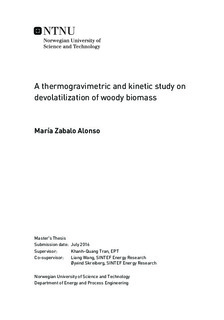A thermogravimetric and kinetic study on devolatilization of woody biomass
Master thesis
Permanent lenke
http://hdl.handle.net/11250/2416090Utgivelsesdato
2016Metadata
Vis full innførselSamlinger
Sammendrag
Biomass is a promising energy resource for a more sustainable global energy outlook. Thermochemical conversion of biomass is a very attractive and important technology for energy generation and production of value-added products such as charcoal. With the aim of studying the internal processes taking place when thermochemical conversion of biomass takes place, in this Master s Thesis a thermogravimetric analysis of woody biomass samples was developed. Woody biomass samples underwent pyrolysis experiments, with the main goal of the development of the kinetic modeling and simulation of the decomposition process. Also, the effect of various experimental parameters was studied for achieving increasing char yield values in pyrolysis processes.
Pyrolysis experiments of hardwood (birch and oak) and softwood (spruce) samples were developed by means of a thermogravimetric analyzer. Besides, two types of samples were studied for each of the mentioned species: stem wood samples and forest residue samples, composed by tops and branches of the trees (named as GROT, the corresponding Norwegian acronym). By means of changing particle size and sample mass of the samples, it was analyzed whether this parameters affected the kinetics of the samples and so, whether reactions were fully kinetically controlled or some heat and mass transfer limitations were needed to be considered. For this, three different kinetic approaches were employed. From the results obtained, it was concluded that the considered experimental parameters had some effects on the kinetics of the samples, as not negligible differences were registered in the values of the kinetic parameters obtained under different experimental conditions. Besides, the heterogeneous nature of GROT samples was also proved in terms of kinetics, in contrast with the high level of repeatability of the stem wood samples. Regarding the study of the char yield, it was concluded that higher char yield values were obtained when developing the pyrolysis experiments in an atmosphere of generated volatiles, rather than in a pure, nitrogen atmosphere. The effect of ash forming elements favoring char yield was also observed, with GROT samples giving the highest values. It was also registered an odd behavior of oak stem wood and GROT samples, which is further explained in this Thesis.
